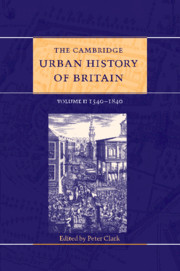Book contents
- Frontmatter
- 1 Introduction
- Part I Area surveys 1540–1840
- Part II Urban themes and types 1540–1700
- 5 Towns in an agrarian economy 1540–1700
- 6 Population and disease, estrangement and belonging 1540–1700
- 7 Politics and government 1540–1700
- 8 Reformation and culture 1540–1700
- 9 The urban landscape 1540–1700
- 10 London 1540–1700
- 11 Great and good towns 1540–1700
- 12 Ports 1540–1700
- 13 Small market towns 1540–1700
- Part III Urban themes and types 1700–1840
- Select Bibliography
- Index
- References
10 - London 1540–1700
from Part II - Urban themes and types 1540–1700
Published online by Cambridge University Press: 28 March 2008
- Frontmatter
- 1 Introduction
- Part I Area surveys 1540–1840
- Part II Urban themes and types 1540–1700
- 5 Towns in an agrarian economy 1540–1700
- 6 Population and disease, estrangement and belonging 1540–1700
- 7 Politics and government 1540–1700
- 8 Reformation and culture 1540–1700
- 9 The urban landscape 1540–1700
- 10 London 1540–1700
- 11 Great and good towns 1540–1700
- 12 Ports 1540–1700
- 13 Small market towns 1540–1700
- Part III Urban themes and types 1700–1840
- Select Bibliography
- Index
- References
Summary
INTRODUCTION: LONDON IN EUROPEAN PERSPECTIVE
‘London is the capital of England and so superior to other English towns that London is not said to be in England, but rather England to be in London, for England’s most resplendent objects may be seen in and around London; so that he who sightsees London and the royal courts in its immediate vicinity may assert, without impertinence that he is properly acquainted with England.’
(Thomas Platter, Travels in England in 1599)London’s growth was a phenomenon of European importance in our period. At the start, London was already a major capital city, ranking sixth in terms of size in mid-sixteenth-century Europe (see Table 10.1). It was dwarfed by the Italian city of Naples and was much smaller than either Venice (ranked second) or Paris (ranked third); and it was outnumbered by the Portuguese capital of Lisbon and London’s principal trading partner, Antwerp. Within fifty years all this had changed. By 1600 London was ranked third in Europe after Naples and Paris, and its neighbour and erstwhile trading partner, Antwerp, was nowhere. Continued growth meant that London came second only to Paris by 1650 and by the end of the seventeenth century was the biggest European city containing some half a million people.
London then developed from a modest capital city, with an economy largely dependent on the export of woollen cloth, to a metropolis at the heart of the European economy. Over our period its population spilled out from the original relatively densely populated districts of the City within and without the Walls (see Plate 1) to form an urban conurbation stretching from Wapping and Poplar in the east to Westminster in the west. Its economic impact on the nation expanded from the immediately adjacent counties to the entire nation, including its overseas colonies. The task of this chapter is to provide some idea of how this extraordinary growth was accomplished and what kind of economy and society it produced.
- Type
- Chapter
- Information
- The Cambridge Urban History of Britain , pp. 315 - 346Publisher: Cambridge University PressPrint publication year: 2000
References
- 14
- Cited by



